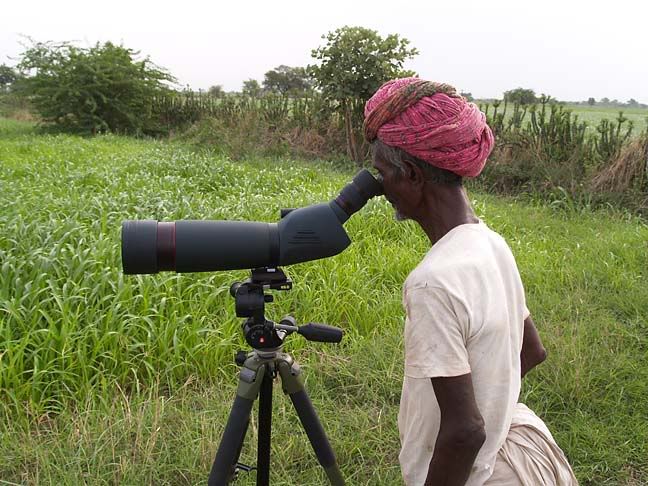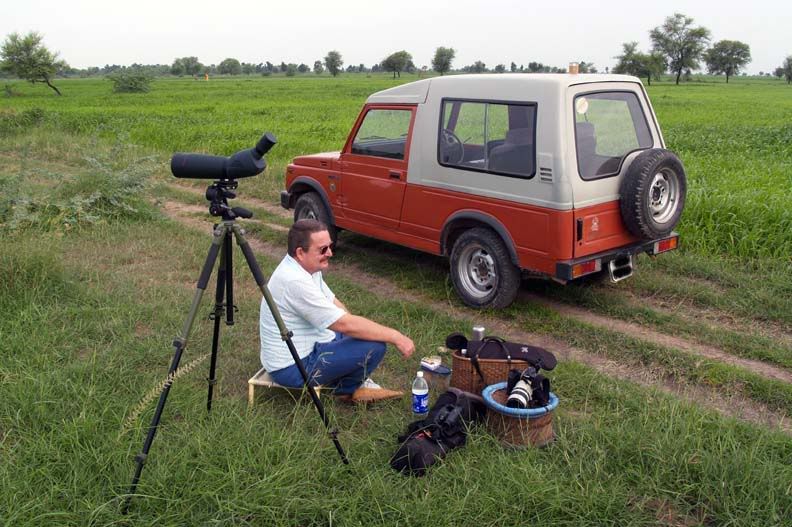A word on Spotting Scopes
Posted: Mon Sep 12, 2011 11:49 am
A word on spotting scopes.
Here ones is trying to give a basic simple guide to spotting scopes, this article does not try to cover any or every detail rather to depart some basic points to its reader. Any mistakes that is made is a mistake and one should be forgiven for it.
Spotting scopes are not telescopes rather a small version of one. Its purposes are to see details at shorter range thus it has a smaller magnification of X40-x60 any higher is not recommended as one begins to loose clarity etc. If one wants to see the outer rings of Alpha Saturnine then one needs a specialised telescope or an Astor scope.
One is not going into which is the best spotting scope or what is the cost. These two depends on ones budget and the requirement of the scope. Nor is one going into which brand is the best.
What is the purpose of the spotting scope?
This is the most important question one needs to ask, this can be bird spotting (looking at bathroom window house across the street, can and will lead to big trouble and thus not advised) or for shooting . The second question is what the max range one would be looking at ?
Straight or angled spotting scope.
The straight scope is straight without angle and has to be at the eye level to see the object and the angle scope the eye piece angled can be angled at 45dgree or 90 degree angle and have to look down wards and or sideways to see the object. The straight scope can easy be pointed at an object and image can be acquired fast.
An angled scope is used in by the Army snipers etc as this can provide low cover and helps in avoiding getting ones head shot off. However the angled scope can easy be moved off the target and takes time to readjust. One has seen shooter in competition, fiddling with angled scopes and wasting ones time. This said, practice makes perfect.
Some desirable options on spotting scope
coating
A good coating works in the same way as one goes to the opticians and orders a pair of spectacles, they ask what coating one wants which type of lens one wants etc . A coating improves the life span of the lens and eliminates the glare just in the spectacles coating , the better the coating the better the view and life span.
Lenses
A chromatic aberration is caused when difference in light wavelength occurs which is most of the time, in some spotting scopes one can see a colour fringing may be seen around a object. This is due to single lens which can not compensate for the chromatic aberration. So what is the options?
If possible go for a spotting scope with an ED glass [Extra low Dispersion] which compensates for the chromatic aberration which occurs at high magnifications.
Scope Numbers
Sometimes the scope would be 9x12x40 the first two numbers refers to the eye piece magnification range and the last to the front of the scope lens
Magnification
magnification of a spotting scope can be 30x -40x or 60x any higher the image quality will deteriorates.
Objective Size
The quality of the image depends on the size of the objective lens. The larger the lens the better is the image quality. Here one should keep in mind that poorer the quality of the glass will produce poor quality images. Therefore it is recommended that one should if possible go for glass like ED- APO. This will depend on what one can afford.
Waterproofing
It is preferable to have a waterproof scope. The waterproofing seal will also protects the spotting scope form water, dust and dirt this will give a long life to the scope.
Cases
A good storing/carrying case is a must this will take up the knocks of life and prevent damage to the scope.
tripod
comes in many sizes etc. A good sturdy legs with non slip shoes are must. The length would depend on the purpose it is used for. In competition shooting from prone to sitting position would need to be taken in to account, as the leg length will be different. A good foam type cover on the legs will prevent bruises occurring while carry the tripod.
If you read this and wish to add something, please do so, as long as it is of value to someone looking to buy a spotting scope.
Here ones is trying to give a basic simple guide to spotting scopes, this article does not try to cover any or every detail rather to depart some basic points to its reader. Any mistakes that is made is a mistake and one should be forgiven for it.
Spotting scopes are not telescopes rather a small version of one. Its purposes are to see details at shorter range thus it has a smaller magnification of X40-x60 any higher is not recommended as one begins to loose clarity etc. If one wants to see the outer rings of Alpha Saturnine then one needs a specialised telescope or an Astor scope.
One is not going into which is the best spotting scope or what is the cost. These two depends on ones budget and the requirement of the scope. Nor is one going into which brand is the best.
What is the purpose of the spotting scope?
This is the most important question one needs to ask, this can be bird spotting (looking at bathroom window house across the street, can and will lead to big trouble and thus not advised) or for shooting . The second question is what the max range one would be looking at ?
Straight or angled spotting scope.
The straight scope is straight without angle and has to be at the eye level to see the object and the angle scope the eye piece angled can be angled at 45dgree or 90 degree angle and have to look down wards and or sideways to see the object. The straight scope can easy be pointed at an object and image can be acquired fast.
An angled scope is used in by the Army snipers etc as this can provide low cover and helps in avoiding getting ones head shot off. However the angled scope can easy be moved off the target and takes time to readjust. One has seen shooter in competition, fiddling with angled scopes and wasting ones time. This said, practice makes perfect.
Some desirable options on spotting scope
coating
A good coating works in the same way as one goes to the opticians and orders a pair of spectacles, they ask what coating one wants which type of lens one wants etc . A coating improves the life span of the lens and eliminates the glare just in the spectacles coating , the better the coating the better the view and life span.
Lenses
A chromatic aberration is caused when difference in light wavelength occurs which is most of the time, in some spotting scopes one can see a colour fringing may be seen around a object. This is due to single lens which can not compensate for the chromatic aberration. So what is the options?
If possible go for a spotting scope with an ED glass [Extra low Dispersion] which compensates for the chromatic aberration which occurs at high magnifications.
Scope Numbers
Sometimes the scope would be 9x12x40 the first two numbers refers to the eye piece magnification range and the last to the front of the scope lens
Magnification
magnification of a spotting scope can be 30x -40x or 60x any higher the image quality will deteriorates.
Objective Size
The quality of the image depends on the size of the objective lens. The larger the lens the better is the image quality. Here one should keep in mind that poorer the quality of the glass will produce poor quality images. Therefore it is recommended that one should if possible go for glass like ED- APO. This will depend on what one can afford.
Waterproofing
It is preferable to have a waterproof scope. The waterproofing seal will also protects the spotting scope form water, dust and dirt this will give a long life to the scope.
Cases
A good storing/carrying case is a must this will take up the knocks of life and prevent damage to the scope.
tripod
comes in many sizes etc. A good sturdy legs with non slip shoes are must. The length would depend on the purpose it is used for. In competition shooting from prone to sitting position would need to be taken in to account, as the leg length will be different. A good foam type cover on the legs will prevent bruises occurring while carry the tripod.
If you read this and wish to add something, please do so, as long as it is of value to someone looking to buy a spotting scope.





